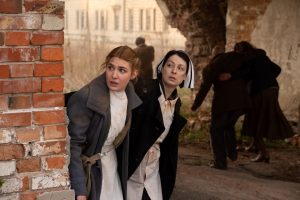Reviews include Irena’s Vow, The Beast, and Before I Change My Mind.
Festival Diary: The 33rd Sundance Film Festival
February 2, 2017
“Presidents come and go; the pendulum swings back and forth.”
Robert Redford settled in for his traditional Sundance opening press conference the day before the inauguration of Donald Trump and insisted the 33rd edition of the festival he founded wasn’t going to play politics.
Sundance’s mission is storytelling, Redford assured. Let the filmmakers make political statements.
But with a climate change denier about to take up residence in the White House, Sundance wasn’t shy about showing its cards, opening the festival with An Inconvenient Sequel: Truth to Power.
Directed by Bonni Cohen and Jon Shenk, the follow to former U.S. vice-president Al Gore’s Oscar-winning climate-change documentary revisits his slide-show talk and explores the escalating toll of global warming.

Coming 10 years after An Inconvenient Truth premiered at Sundance, it shows an occasionally angry and frustrated Gore detailing the shocking human cost of climate change. Driven to see change accomplished, he surprisingly also had some good news to share about potential environment saviours.
The crowd in the Eccles Theater, a high school transformed into the main Sundance venue, treated Gore like a returning hero and were rewarded with a rousing post-screening speech.
There was a palpable mood of political frustration in Park City throughout Sundance opening weekend, culminating in the Saturday morning Women’s March, where sitting in a 9 a.m. screening seemed counterproductive.
It drew some 8,000 people, including Nick Offerman, seen sporting a pink pussy hat.

I was determined to join the march but a massive snowstorm messed with Park City’s free transit system and it took more than 90 minutes to get to Main Street from my hotel in the Canyons ski area about 10 km away. I made it for the tail end of the march, followed by passionate speeches from Maria Bello, Jessica Williams, Chelsea Handler and “si, se pueda” civil rights activist Dolores Huerta.
I had opted to stay off-campus outside Park City to swerve the ridiculous rates at even the cheapest central hotels. My place was still on a free city bus line, but I also dug the name; like I was living on the set of a CW series or a cheesy Lindsay Lohan drama.
The downside was the last Canyons bus left the stop outside the former Yarrow Hotel in Park City, now minimally tarted up as DoubleTree by Hilton, at 12 a.m. That meant no parties on Main Street or midnight screenings and a race to the bus stop after a 9 p.m. movie let out at the Eccles.
That’s the trick about covering Sundance: finding a way to emerge without getting financially brutalized by ski resort prices and the U.S. exchange, while getting around the spread-out screening venues in a perpetual snowstorm.

The bus around the theatre loop is free, while Uber has surge pricing and taxis are impossible to hail. The Fresh Market has prices in line with Loblaws for loading breakfast items into your room, but add the exchange rate and a bottle of juice seems like an extravagance. There’s a dearth of healthy grab-and-go food at theatres, which means a week of protein bars, Starbucks, and the occasional squished sandwich.

Interviews can be easy to set up but challenging to do, especially ones held in Main St. retailers that have been repurposed as media suites with couches and product placements. They’re noisy and there are often a half-dozen interviews going on around the room. I spent a lot of time sitting on a knee-crunching “poof” – a glorified pillow – squatting like an adult in a kindergarten chair as I waited my 10-minute turn.
I missed out on what I heard was an outstanding VR program and the free Main Street music cafés, as well as Slamdance. Typical of any film festival, the must-do assignment list nudges out things on the want-to-see list.

But I did see some films that I suspect will be among TFCA member favourites in 2017, especially Michael Showalter’s The Big Sick, Dee Rees’s Mudbound, award-winning doc Rumble: The Indians Who Rocked the World by Montreal-based filmmakers Catherine Bainbridge and Alfonso Maiorana, and 78/52, Alexandre Philippe’s black-and-white documentary exploring the 78 camera setups and 52 cuts used to create the famous shower scene in Alfred Hitchcock’s Psycho.
It made my film-nerd heart soar, just what we love about the joy of discovery that comes courtesy of a film festival. — Linda Barnard



